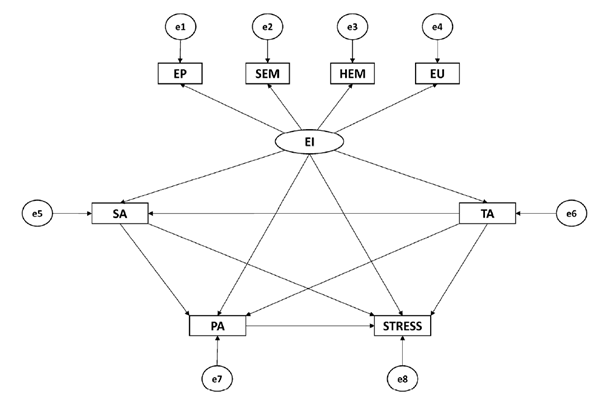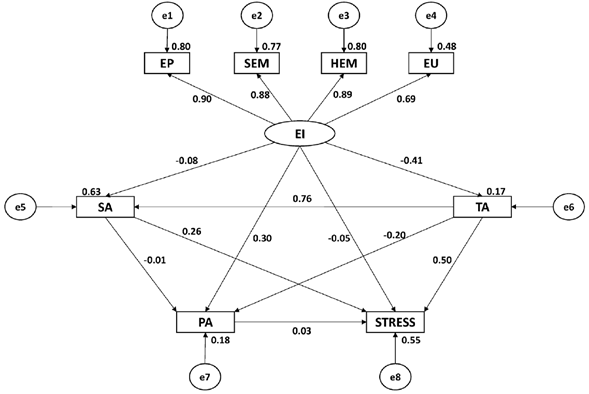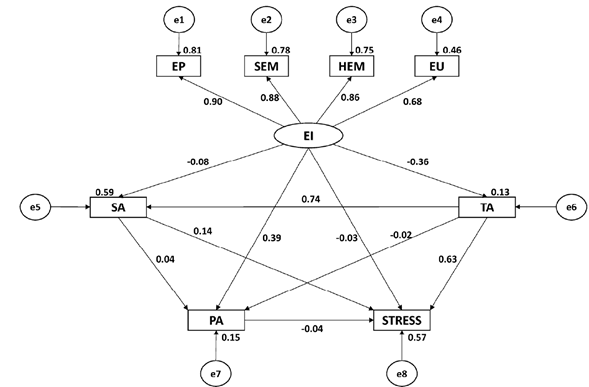In recent decades, Emotional Intelligence (EI) has begun to be considered as a powerful tool in the educational ambit, as it is a protective and facilitating factor for physical and mental health, as well as a better social, personal and educational adjustment (Cardona et al., 2021; Jiménez et al., 2020; Morales, 2017; Pena & Repetto, 2008; Rodríguez- Rodríguez, 2020). Taking into account the paradigm of trait EI and a tetra-dimensional conception, EI can be defined as self-perceptions regarding the ability of individuals to perceive emotions (emotional perception), manage their own emotions (self-emotional management) and those of others (hetero-emotional management), as well as use them (emotional utilisation) to direct their own thoughts and actions (García-Coll et al., 2013; Salovey & Mayer, 1990). The gender differences and the components of EI are controversial (Brackett & Salovey, 2006; Joseph & Newman, 2010), although there is greater evidence that females have better interpersonal skills, while males have greater intrapersonal ability (Ayyappa & Balakrishna; 2014; Bar-On, 2006). In addition, certain research suggests connections between trait EI and anxiety and stress, finding a negative association (Serrano & Andreu, 2016; Solla & Morales- Rodríguez, 2021), as well as a positive association such as physical-sports practice (Puertas-Molero et al., 2017). In this sense, the study carried out by Luna et al. (2019) showed that a physical-sports intervention programme promoted significant improvements in the subjective well-being and trait EI of the participating adolescents. Therefore, in the educational context, in which adolescents frequently suffer situations of anxiety and stress, and in which there are optimal conditions for physical activity engagement, knowing the relationships with trait EI, as well as the relationships between the aforementioned variables, would be of great benefit for psychoeducational applications in the classroom.
During the adolescent stage, symptoms of anxiety frequently arise due to the stressful factors present in the relational and academic environment (Hawk et al., 2019). In this educational context, several studies have underscored the presence of high levels of anxiety in Spanish children and adolescents, although all types of manifestations (Solla & Morales-Rodríguez, 2021; Torrano-Martínez et al., 2017) are found to be more prevalent in females than in males (Rojo et al., 2014; Solla & Morales-Rodríguez, 2021). With regards to trait EI, several studies have evidenced that low levels of EI predict psychologically maladaptive behaviours, in which high levels of anxiety are found (Fernández-Berrocal et al., 2006; Solla & Morales-Rodríguez, 2021). Likewise, corresponding research, besides verifying the inverse association between trait EI and the internalisation of problems such as anxiety, has detected that this association is stronger in female secondary-school students than their male counterparts (Salavera et al., 2019).
In line with the aforementioned considerations, the educational and academic context is regarded as one of the main sources of stress for secondary school students (de Anda et al., 2000). With respect to gender, diverse research studies have argued that higher stress levels are perceived by female adolescents relative to their male peers (Kulakow et al., 2021; Pierkarska, 2020). On the other hand, other studies did not perceive this difference, whilst some did but in relation to different types of stressors (Hankin et al., 2007; Liu & Lu, 2011). With regards to trait EI and stress, some studies have reported a negative relationship between these two variables (Augusto-Landa et al., 2008; Extremera et al., 2009; Serrano & Andreu, 2016). Likewise, studies such as the one conducted by Morales (2017) have revealed that secondary school students with higher scores of trait EI also engage more often in productive coping strategies in order to deal with stress.
In reference to physical activity engagement, existing literature points to the benefits this exerts on physical, psychological and social health starting from young ages (Biddle et al., 2019; Cooper et al., 2018; Malm et al., 2019). Physical activity engagement has, therefore, been considered a protective factor against, for example, anxiety, as it favours meaningful reductions in state anxiety, trait anxiety and related physiological indicators. In the same way, evidence has been presented that shows that individuals who engage in regular physical activity report decreased stress levels (Bougea et al., 2018). In addition, another systematic review carried out by Puertas- Molero et al. (2017) on the influence of sports engagement on EI concluded that students who performed physical exercise improved in their EI. This has also been evidenced in an experiment showing higher levels of satisfaction with oneself, and quicker and more efficient decision making when faced with stressful situations (Adilogullari & Senel, 2014, Bhochhibhoya et al., 2014). Furthermore, with regards to differences based on gender, the majority of studies underscore that males tend to engage in more physical activity outside of the educational context. At the same time, this has repercussions which lead to greater EI (Chacón-Cuberos et al., 2017; Herrera-Gutiérrez et al., 2012).
Based on the above, the present research hypothesises a theoretical model based on eight observable variables (emotional perception, self-emotional management, hetero-emotional management, emotional utilisation, state anxiety, trait anxiety, stress, and physical activity engagement) and a latent variable (trait EI), in which: All four trait EI indicators assessed (emotional perception, self-emotional management, hetero-emotional management, and emotional utilisation) will have a positive association with overall trait EI in both genders, although the association of the self-emotional management indicator will be stronger in boys while the hetero-emotional management indicator will be stronger in girls (Hypothesis 1); Trait EI will be negatively associated with anxiety (state and trait) in both genders (Hypothesis 2); State anxiety and trait anxiety will be positively associated in both genders (Hypothesis 3); Trait EI will be positively associated with physical activity engagement in both genders (Hypothesis 4); Trait EI will be negatively associated with stress in both genders (Hypothesis 5); Physical activity engagement will be negatively associated with anxiety (state and trait) in both genders (Hypothesis 6); Anxiety (state and trait) will be positively associated with stress in both genders (Hypothesis 7); and Physical activity engagement and stress will be negatively associated in both genders (Hypothesis 8).
For this purpose, the present research proposes the following objectives: (a) Define and compare an explanatory model of levels of trait EI, anxiety, stress and physical activity engagement. (b) Analyse existing associations between levels of trait EI, anxiety, stress and physical activity engagement based on the gender of adolescents, via a multi-group structural equation model.
Method
Design and participants
The present study was descriptive and cross-sectional in nature. It was carried out with a total sample of 2452 adolescents of both genders (42.7% males and 57.3% females) aged between 13 and 16 (M = 14.43 years; SD = 1.15). Participants were partaking compulsory secondary education in Granada (Spain). Sample selection was carried out by means of a process of convenience sampling, attending to the following inclusion/exclusion criteria: (a) participants were partaking compulsory secondary education in Granada and (b) they were not suffering from any type of pathology which could impede their participation in the research. The sample was recruited from nine schools in Granada. All schools that voluntarily agreed to collaborate were invited to participate.
Instruments
Schutte Self Report Inventory (SSRI). A questionnaire originally conceived by Schutte et al. (1998) to estimate trait EI according to a single-factor solution. Adapted by García- Coll et al. (2013) to the tetra-factorial model in which based on 30 items with 5 response options on a Likert scale (ranging from 1 “Strongly disagree” to 5 “Strongly agree”) the following dimensions are assessed: emotional perception (e.g., “I expect good things to happen”), self-emotional management (e.g., “I know why my emotions change”), hetero-emotional management (e.g., “Other colleagues find it easy to trust me”) and emotional utilisation (e.g., “When I feel a change in my emotions, I tend to have new ideas”). A study conducted by García-Coll et al. (2013) established a reliability index of α = .91 for general trait EI, with indices for individual dimensions registered as follows: emotional perception α = .79, management of self-relevant emotions (α = .77), management of others’ emotions (α = .78) and utilisation of emotions (α = .63). In the present research, the obtained values were highly similar, with the index pertaining to trait EI being α = .91, emotional perception being α = .76, management of self-relevant emotions being α = .75, management of others’ emotions being α = .78 and utilisation of emotions being α = .67.
State-Trait Anxiety Inventory (STAI). The STAI (Spielberger et al., 1970, adapted by Buela-Casal et al., 2015) was used to estimate levels of state and trait anxiety. The questionnaire is composed of 40 items which pertain to two levels, namely, state anxiety (anxiety produced at a specific moment in time and caused by a stimulus which is interpreted as threatening; e.g., “I feel calm”) and trait anxiety (anxiety that is prolonged over time and is characterised by the tendency of individuals to react in an anxious way when faced with stimuli which are not normally considered as stressors; e.g., “I am content”). This instrument is assessed using a four-choice Likert scale, ranging from 0 (not at all) to 3 (very much). For the present research, a reliability index, calculated via Cronbach alpha, of α = .95 was produced for this instrument. A reliability index of α = .92 was calculated for the sub-scale pertaining to state anxiety, whilst α = .89 was produced in relation to trait anxiety.
Perceived Stress Scale (PSS). This instrument was extracted from the original version described by Cohen et al. (1983) and adapted into Spanish by Remor (2006). The questionnaire is composed of 14 items that evaluate the levels of stress perceived by individuals during the one-month period prior to administration (e.g., “How often have you felt that things are going well for you?”), using a five-choice Likert scale ranging from 0 (never) to 4 (very often). Remor (2006) obtained an internal consistency (Cronbach alpha) index of α = .81. This value is similar to that obtained in the present research α = .84.
Physical Activity Engagement (PAQ-A). The original questionnaire conceived by Kowalski et al. (1997) was adapted and validated into Spanish by Kowalski et al. (2004). The questionnaire evaluates the physical activity engagement of participants over the seven days prior to administration, with this being considered an indicator of regular physical activity or sports engagement. The instrument is composed of 9 items regarding the type and frequency of activities performed. An example item is “In the last 7 days, during your physical education (PE) classes, how often were you very active (playing hard, running, jumping, throwing)? (Check only one.)” and the response options are “I do not do PE; Almost never; Sometimes; Quite often; Always”. For this instrument, a consistency index of α = 0.89 was obtained, this being acceptable and slightly better than the value obtained by Kowalski et al. (2004) in the original study (α = .79).
Procedure
By way of the Education Commission of the Local Government of Andalusia, the collaboration of selected schools in Granada was requested through a process of convenience sampling. The local commission pertinent to participating schools was informed regarding the nature of the research and the collaboration of students was requested. Given that research participants were not of the age of legal consent, a permission form was sent to the adolescents’ legal guardians requesting their informed consent.
At all times, the anonymity of participants was guaranteed, specifying that the data collected would only be used for scientific purposes. Researchers were present during data collection in order to ensure that processes were correctly followed and to resolve any doubts.
Following data collection, a total of 102 questionnaires had to be discarded due to having been incorrectly filled out. The present research followed the guidelines laid out in the Declaration of Helsinki (World Medical Association, 2008) relative to research projects, in addition to national legislation regarding clinical trials (Law 223/2004 of the 6th of February), biomedical research (Law 14/2007 of the 3rd of July) and participant confidentiality (Law 15/1999 of the 13th of December).
Data analysis
The statistical software IBM SPSS® in its version 22.0 for Windows was used for the analysis of basic descriptive data. The programme IBM AMOS® 23 was used for analysing existing relationships between the constructs included in the structural model. Following development of the theoretical model, path analysis was performed which considered the relationships produced within the matrix developed via multi-group analysis, grouping participants based on gender. Finally, two different structural models were configured in order to verify whether relationships between studied variables varied based on the gender of adolescents.
Path models were formed from eight observable variables and one latent variable in order to determine indicators (Figure 1). In the proposed models, causal explanations pertaining to the latent variable were formed based on the relationships observed between indicators. This considered the reliability of estimations. Likewise, observable variables included measurement error terms so as to directly control error. Unidirectional arrows represent lines of influence between latent and observable variables, with these being interpreted as multivariate regression coefficients.
Trait emotional intelligence (EI) acts as an exogenous variable and is inferred by four indicators, these being EP (emotional perception), SEM (management of self-relevant emotions), HEM (management of others’ emotions) and EU (utilisation of emotions). State anxiety (SA) acts as an endogenous variable, receiving the effects of EI and trait anxiety (TA). Trait anxiety (TA) acts as an endogenous variable, receiving the effects of EI. Physical activity engagement (PA) acts as an endogenous variable, receiving the effects of EI, state anxiety (SA) and trait anxiety (TA). Likewise, stress (STRESS) acts as an endogenous variable, receiving the effects of EI, state anxiety (SA), trait anxiety (TA) and physical activity engagement (PA).
Model fit was examined with the aim of verifying compatibility between the model developed and the empirical information obtained. The reliability of model fit was examined according to goodness of fit criteria established by Marsh (2007, p.785).
Results
The structural equation model proposed, according to the gender of analysed students, revealed good fit in all evaluation indices. Chi-squared analysis produced a significant p-value (χ2 = 349.020; df = 28; p < .001). Nonetheless, this index cannot be interpreted in a standardised way and also poses problems with regards to sensitivity to sample size (Marsh, 2007, p.785). As a result, other standardised fit indices were employed which are less sensitive to sample size. The comparative fit index (CFI) obtained was 0.973, with this being excellent. The normalised fit index (NFI) specified a value of 0.971, whilst the incremental fit index (IFI) was 0.973, with both being excellent. Root mean square error of approximation (RMSEA) obtained an adequate value of 0.068.
Figure 2 and Table 1 present values estimated for parameters included in the structural model for male adolescents. In order to be considered meaningful, these values must present sufficient magnitude and be significantly different from zero. Likewise, improper estimations must not be obtained as reflected by negative variances.
Table 1 Structural model pertaining to boys
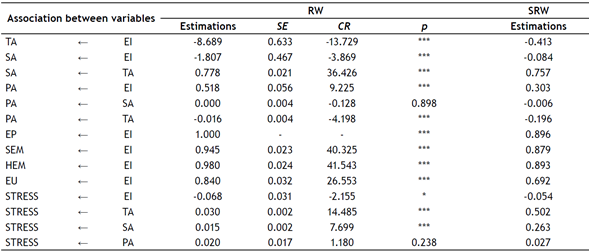
Note 1. EI: trait emotional intelligence; EU: utilisation of emotions; SEM: management of self-relevant emotions; HEM: management of others’ emotions; EP: emotional perception; TA: trait anxiety; SA: state anxiety; PA: physical activity; STRESS: stress.
Note 2. RW: regression weights; SRW: standardized regression weights; SE: standard error; CR: critical ratio.
Note3. *p < .05; **p < .01; ***p < .001.
Analysing the influence of EI indicators, statistically significant differences were found at the level of p < .001, with all of these being positive and direct. It was observed that all indicators had a similar influence, with EP being the indicator producing the highest correlation coefficient (r = .896), followed by HEM (r = .893) and SEM (r = .879), with EU being the dimension exerting the least influence (r = .692).
When the association between EI and levels of anxiety were analysed, significant indirect and negative associations (p < .001) were observed, in the case of both SA (r = -.048) and TA (r = -.413), although a stronger correlation was seen in relation with the latter. A positive direct association (p < .001) existed between SA and TA (r = .757).
A significant positive and direct association (p < .001) was found between EI and PA, with the correlation being of moderate strength (r = .303). When analysing the association between EI and STRESS levels, the existence of a significant association (p < .01) was confirmed, this being negative and indirect (r = -.054).
The relationship between anxiety levels and PA was revealed to be negative and indirect. In the case of TA, this association was significant at the level of p < .001 (r = -.196), however, this association was not found to be significant in the case of SA (p = .898).
With regards to levels of anxiety and STRESS, a positive and direct relationship was observed at the level of p < .001, with this being stronger in the case of TA (r = .502) and weaker in the case of SA (r = .263).
Finally, no association was found between PA and STRESS levels (p = .238).
Figure 3 and Table 2 present the values estimated for the parameters included in the structural model pertaining to female adolescents. In order to be considered meaningful, these values must be of sufficient magnitude and significantly different from zero. Likewise, improper values must not be obtained, with these being reflected by negative variances.
Table 2 Structural model pertaining to girls
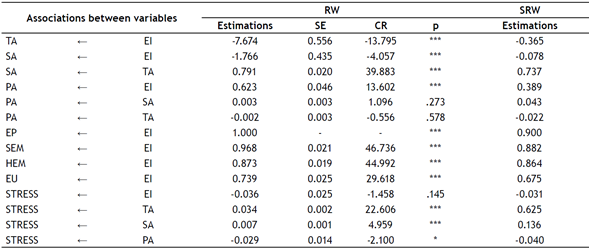
Note 1. EI: trait emotional intelligence; EU: utilisation of emotions; SEM: management of self-relevant emotions; HEM: management of others’ emotions; EP: emotional perception; TA: trait anxiety; SA: state anxiety; PA: physical activity; STRESS: stress.
Note 2. RW, regression weights; SRW, standardised regression weights; SE, standard error; CR, critical ratio.
Note 3. *p < .05; **p < .01; ***p < .001***.
When analysing the influence of EI indicators, statistically significant differences were found at the level of p < .001, with all relationships being positive and direct. Indicators were observed to have a similar influence, with EP being the indicator to show the greatest correlation coefficient (r = .900), followed by SEM (r = .882) and HEM (r = .864), with EU being the dimension to exert the least influence (r = .675).
When the association between EI and anxiety levels was analysed, significant negative and indirect associations were observed (p < .001) in the case of both SA (r = -.078) and TA (r = -.365), although the strongest correlation was found to pertain to the latter. A positive and direct association (p < .001) was found between SA and TA (r = .737).
A significant association was found between EI and PA (p < .001). This association was positive and direct, with the relevant correlation being of moderate strength (r = .389). When analysing the association between EI and STRESS levels, it was confirmed that no significant association existed (p = .145).
The association between levels of anxiety and PA was not found to be significant, neither for TA (p = .578), nor in the case of SA (p = .273).
With regards to levels of anxiety and STRESS, a positive and direct relationship was observed at the level of p < .001, with this correlation being stronger in the case of TA (r = .625) and weaker in the case of SA (r = .136).
Finally, when the association between PA and STRESS levels was analysed, a significant, negative and indirect association was observed (p < .05; r = -.040).
Discussion
The aims of the present study consisted of defining and comparing an explanatory model of the associations between levels of EI, anxiety, stress and physical activity engagement in both genders, by means of multi-group structural equation analysis. Outcomes revealed that the path model developed presented excellent fit indices. This suggested that a valid explanatory model was constructed which enables the explanation of associations existing between these variables in adolescent boys and girls, as has been performed in other similar studies (Hernández et al., 2018; Schoeps et al., 2019; Schoeps et al., 2021; Wang et al., 2020).
The structural equation model proposed confirmed hypothesis 1 partially, since with regards to EI, the influence of all indicators was proportionally similar. Additionally, similar correlations were found between boys and girls, with the indicator producing the strongest correlation pertaining to emotional perception. However, in the case of boys, the second strongest indicator was found to be the management of others’ emotions, whilst, in the case of girls, the second strongest indicator was the management of self-relevant emotions, contrary to what has been hypothesised. In this sense, given the existing controversies with regards to gender differences in EI and the components that comprise it (Brackett & Salovey, 2006; Joseph & Newman, 2010; Sarrió et al., 2002), outcomes from the present research contrast with findings reported in other studies which emphasise that females appear to possess better interpersonal skills than males, whilst males have a greater intra-personal capacity and manage their emotions better than females (Ayyappa & Balakrishna; 2014; Bar-On, 2006). In addition, outcomes of the present research revealed that the indicator to produce the weakest correlation, regardless of gender, was the utilisation of emotions. This finding is in line with reports by other authors who have argued that the utilisation of emotions is the least valued indicator by adults of either gender (Castro-Sánchez et al., 2018).
Another notable outcome was that EI was found to be negatively related with anxiety levels, confirming hypothesis 2. This was the case for both state and trait anxiety, although a stronger correlation was found, for both boys and girls, in the case of trait anxiety. Thus, the explanatory model proposed reinforces the idea that lower EI is associated with higher levels of anxiety, in accordance with findings reported in other research studies (Fernández-Berrocal et al., 2006; Solla & Morales-Rodríguez, 2021). As a consequence, the promotion of emotional skills in adolescents should be recommended as a means of preventing problems, such as anxiety, from being internalised starting from an early age. Likewise, another of the findings obtained pertained to an association between trait and state anxiety, regardless of gender, confirming hypothesis 3, although a slightly stronger correlation was seen in boys. This association between state and trait anxiety is coherent with the standpoint discussed by Spielberger et al. (1970). In this sense, these authors state that individuals with high trait anxiety scores are expected to present high state anxiety scores, given that individuals with elevated trait anxiety are more likely to respond to threatening situations with an increase in state anxiety.
The structural equation model proposed revealed that a positive and direct association existed between EI and physical activity engagement, confirming hypothesis 4, with a stronger correlation being produced in the case of girls. These outcomes coincide with those reported by various research studies which have outlined that physical activity or sports engagement is positively associated with EI. Specifically, previous research indicates that physical activity engagement facilitates the development of interpersonal and intrapersonal abilities, thus favouring knowledge of oneself, emotional expression and understanding others (Adilogullari & Senel, 2014, Bhochhibhoya et al., 2014; Guszkowska et al., 2016; Kim et al., 2016). For this reason, it is recommended that emotional skills should be developed in adolescents by way of physical activity, as indicated by the results obtained by Luna et al. (2019).
Another outcome produced by the explanatory model, with regards to EI and stress levels, is that the existence of a negative association was confirmed in boys, whilst no association was found to exist in girls, partially confirming hypothesis 5. The inverse association found in boys between EI and stress levels, supports outcomes reported by other previous research carried out in different populations, such as adults, university students and adolescents in general (Augusto-Landa et al., 2008; Extremera et al., 2009; Serrano & Andreu, 2016). In the case of girls, failure to find an association between EI and levels of perceived stress could suggest that, in participating adolescents, perceived levels of stress exceeded coping strategies, despite EI generally being rated highly (Morales, 2017). Obtained data did not permit the existence of an inverse relationship to be supported in the way it has been in previous research (Serrano & Andreu, 2016).
Likewise, outcomes based on the present research highlighted that, in the case of girls, no association was found between levels of anxiety and physical activity engagement, rejecting hypothesis 6 in girls. Nonetheless, in the case of boys, a negative and indirect association was found between physical activity engagement and trait anxiety, partially confirming hypothesis 6. Outcomes obtained within the group of boys coincide with findings reported in other research, such as that carried out by Herrera-Gutiérrez et al. (2012). In this study, adolescents who engaged in more physical activity within the school setting were observed to present lower levels of trait anxiety. The fact that no significant association was found in participants of the present study, may be due to physical activity engagement not compensating for the high levels of anxiety that tend to emerge in females compared to males (Rojo et al., 2014; Solla & Morales-Rodríguez, 2021).
In the present study, a positive association was also observed in participating adolescents, regardless of gender, between anxiety and stress, with the strongest association emerging in relation to trait anxiety, confirming hypothesis 7. These outcomes are in line with prior theory and research which indicates that adolescents who experience more anxiety, mainly trait anxiety, also report a greater number of negative and stressful life events (Moreno et al., 1995; Solla & Morales-Rodríguez, 2021).
Finally, no association was found between physical activity engagement and stress levels, in the case of boys, whilst a negative and indirect association was observed in girls, partially confirming hypothesis 8. In this way, outcomes perceived within the group of girls are in line with other outcomes, which concluded that regular physical activity engagement leads to a reduction in stress levels. Nonetheless, outcomes pertaining to the group of boys contradict these prior findings (Bougea et al., 2018). As a result, it is necessary to delve deeper into lines of research which consider the relationship between physical activity engagement and stress levels based on gender.
In another consideration, it is worth mentioning that the present study contains certain limitations. For instance, a descriptive and cross-sectional research design was employed which makes it difficult to make inferences with regards to causal relationships. Another limitation pertains to the type of sampling carried out. As convenience sampling was employed, hence conclusions cannot be extracted for generalisation to the entire population of Spanish adolescents. It is, therefore, recommended that future research is carried out with representative samples of the Spanish adolescent population.
Finally, although, as previously indicated, causal relationships cannot be established between the studied variables, obtained outcomes allow practical implications to be established with regards to the utility of working with adolescents to reinforce physical activity engagement. The aim of this is to favour EI and decrease levels of anxiety and stress, whilst considering the differences that emerged based on gender. Likewise, it is urged that the Promotion and development of EI occurs starting from an early age given that it is associated with lower levels of anxiety and stress, in addition to greater physical activity engagement. As a consequence, it is likely to have positive repercussions on the quality of life of adolescents.














